- Basic science
- Species in use
- Mechanism of action
- Clinical practice
- Indication
- Contraindication
- Side effects
- Options for dressing
- Clinical application
(net boot) - Clinical application
(cage dressing) - Clinical application
(biobag) - Clinical cases
- Cases Part1
- Cases Part2
- Treatment result
- Products
- Products lineup
- Production facilities
- References
- ~2012
- ~2000
- ~1985
- Contact address

Clinical application of cage dressing method
(The standard duration of maggot application is 48-72 hours.)
Pictures are provided by Dr. Yagi, Yagi Clinic, Japan.
Stop using any topical ointments or creams that might inhibit the growth of maggots. If the wound surface is covered with hard and dry necrotic tissue, it is best to soften the wound bed using wet gauze or a hydrocolloid/hydrogel dressing
| <Day 1> 1. Wound bed preparation Ensure that no ointment, cream or dressing material remains on the wound. |
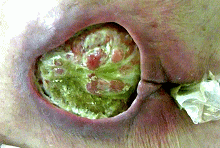 |
| 2. Making the side walls of the cage dressing
(1) Cut out a sheet of thick wound dressing in the shape of the wound. (2) Place the dressing in alignment of the edges of the wound. |
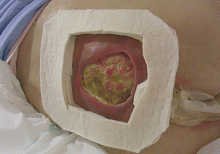 |
| 3. Taking out the maggots
(1) Take the maggots with gauze out of the tube. | 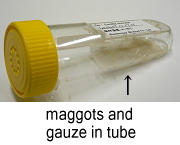 |
|
(2) Maggots remaining in the tube can be flushed out with saline onto a piece of gauze. |
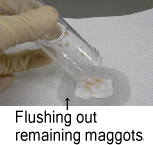 |
| 4. Setting maggots on the wound
(1) Put the maggots with gauze on the wound. (2) Put several more pieces of gauze on the wound to absorb excess exudation. | 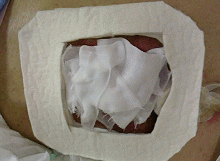 |
| 5. Making the top of the cage dressing
(1) Put a fine mesh sheet on the top of the dressing. (2) Fix the mesh sheet onto the top of the side walls using adhesive tape. (3) A breathable absorbent sheet can also be placed over the cage dressing if a large amount of exudation is predicted. | 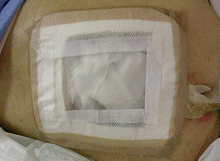 |
| <Day 2–3> If there is a problem with exudation or odor, the outer absorbent sheet can be replaced. |
|
| <Day 4> 1. Removal of the outer dressing Remove the outer absorbent sheet, mesh sheet, and gauze. 2. Removal of the maggotsRemove the maggots using tweezers and water. They are supposed not to burrow into living tissue, but care should be taken not to leave them on the wound. |
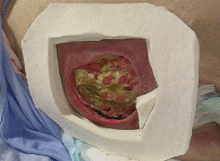 |
